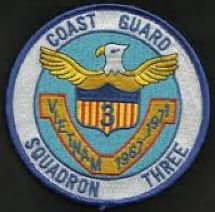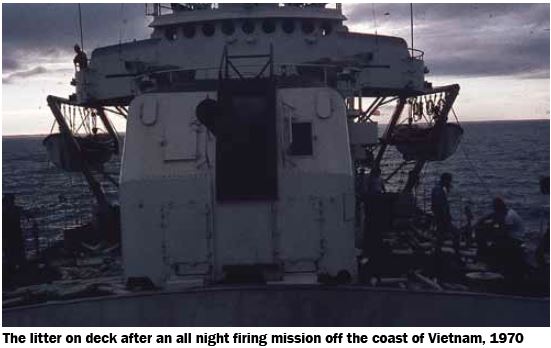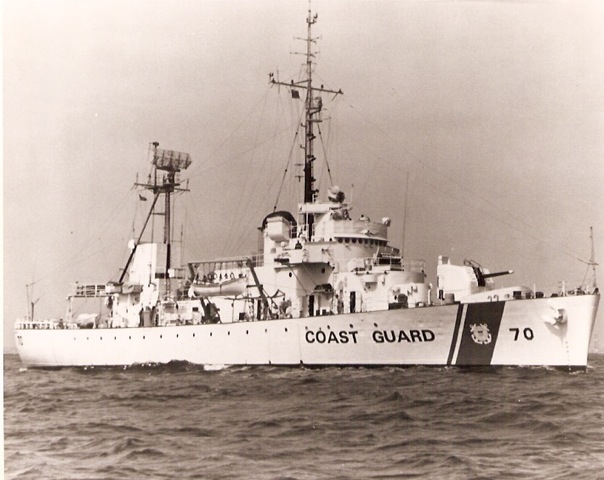This was the second question asked me by an Air Force colonel, when we were assigned together in Vietnam in the 1960s. Eyeing my cap device, his first question had been a polite, “What navy are you in?”
What’s the Coast Guard doing in Vietnam?” was a question I would hear many times during my tour. I served as commanding officer of the U.S. Coast Guard cutter Pontchartrain, a 255-foot, high-endurance cutter. As a unit of Coast Guard Squadron Three, the Pontchartrain, along with four other Coast Guard cutters, was part of Cruiser-Destroyer Group, U.S. Seventh Fleet. These cutters joined U.S. Naval vessels patrolling offshore on Operation Market Time, designed to deny the North Vietnamese the ability to resupply their army and the Viet Cong from the sea. An additional duty was to provide naval gunfire support to friendly forces with our 5-inch/38-caliber gun. Two of the more frequent users of this service were the American Division at Chu Lai and the U.S. Naval Riverine Force at Song Ong Doc. The fact that the Coast Guard cutters were armed with this weapon allowed the Navy to reduce the number of destroyers on the gun line and use their greater capability elsewhere in the Seventh Fleet.
The first Coast Guard 82-foot patrol boats arrived in Vietnam in July 1965. They became part of the newly formed Navy Coastal Surveillance Force (CTF-115, Market Time). Their numbers ultimately increased to 29, as their effectiveness in interdiction became apparent. U.S. Navy Swift Boats would later be added to CTF-115. In 1965, however, the Coast Guard had the only small patrol craft capable of operating close inshore and up the rivers.
Coast Guard Squadron Three, composed of five high-endurance cutters, reported to Commander, Seventh Fleet, for Market Time duty on 4 May 1967, and remained in the combat area until January 1972. On 15 August 1970, under the U.S. Vietnamization program, the last of the 82-foot cutters was turned over to the Vietnamese Navy, and Coast Guard Squadron One was disestablished.
 Although the extent of Coast Guard Operations in Vietnam is now, and was then, largely unknown to the general public, Coast Guard high-endurance cutters and patrol boats engaged in coastal interdiction with the Navy. Coast Guard port security and explosive-loading detachments served with the Army, and Coast Guard helicopters flew combat rescue missions with the Air Force. Coast Guard buoy tenders provided and maintained aids to navigation in U.S. military ports, and Coast Guard marine safety personnel supported merchant vessel operations. The Coast Guard built, maintained, and operated a chain of electronic navigation stations in Vietnam and Thailand, which provided accurate and reliable all-weather navigation data in support of U.S. air and surface operations. The accomplishment of these tasks involved a large portion of the Coast Guard’s ships and approximately 45,000 personnel.
Although the extent of Coast Guard Operations in Vietnam is now, and was then, largely unknown to the general public, Coast Guard high-endurance cutters and patrol boats engaged in coastal interdiction with the Navy. Coast Guard port security and explosive-loading detachments served with the Army, and Coast Guard helicopters flew combat rescue missions with the Air Force. Coast Guard buoy tenders provided and maintained aids to navigation in U.S. military ports, and Coast Guard marine safety personnel supported merchant vessel operations. The Coast Guard built, maintained, and operated a chain of electronic navigation stations in Vietnam and Thailand, which provided accurate and reliable all-weather navigation data in support of U.S. air and surface operations. The accomplishment of these tasks involved a large portion of the Coast Guard’s ships and approximately 45,000 personnel.

Photo of U.S. Coast Guard cutter PONTCHARTRAIN off the coast of Vietnam, 1970, taken by LeRoy Reinburg, Jr.
The Coast Guard is justifiably proud of its military heritage. It has participated in every armed conflict in our nation’s history. The Coast Guard was established as an armed service by legislation enacted in 1915, although its forerunner, the Revenue Marine and Revenue Cutter Service, had held comparable status since 1799. Title 14 of the United States Code is the basic authority for this military status. Section 1 provides that the Coast Guard will be at all times a military service and a branch of the armed forces, although a component of the Department of Transportation, except when operating in the Navy.* Section 2 of that title states that the Coast Guard “shall maintain a state of readiness to function as a specialized service in the Navy in time of war.” Section 3 describes the Navy-Coast Guard relationship and states that the Coast Guard will operate as a service within the Department of the Navy (much the same as the Marine Corps) during time of war or when the President directs. This transfer has occurred only twice, during World Wars I and II. Coast Guard forces have been operational control of the Navy in all U.S. armed conflicts since World War II, however, and continue to serve in Southwest Asia and the Adriatic even today.
So when asked, “What was the Coast Guard doing in Vietnam?”, the answer is simply that it was performing its military function mandated by law.
*On 25 February 2003, the Coast Guard became part of the Department of Homeland Security. However, the Coast Guard still upon the declaration of war or when the President directs operates as a service in the Department of the Navy. (See Wikipedia’s History of the United States Coast Guard for a concise summary of key events in the Coast Guard’s history.)
(Originally published in Officer Review, Vol. 39 No. 3, October 1999, The Military Order of the World Wars.)


My dad, Chief Petty Officer Willard “Bill” Moore, served on the USCGC Sebago in Vietnam. He never talked about it and has passed. I would like to connect with anyone who knew him during his service or that has details of the Sebago’s day to day actions either from Vietnam or Pensacola.
Any info too on how I can obtain his service records would be very much appreciated.
Coast Guard Cutter Mendota (WHEC 69) Squadron Three VietNam
Proudly served onboard
Richard Morris
Retired USCG / CWO3
I served in the CG from 64-68. Never served in Nam but just reading normal newspapers I knew they were there. Some people have a rifle scope outlook on life.
Sir, I served on the Ponch for 2.5 years . 11 ocean station stations. I was discharged June of 67. Good times, Alpha 41 boot camp in Alameda Ca. Our last CO was capt Johnson.
I served as a seaman on board the USCGC Pontchartrain in 1970.
Mr. Moreno,
Dad always spoke so highly of all who served on the USCGC Pontchartrain — thank you for your service, sir!
All best wishes to you, and thank you for visiting and for posting on our website,
Claire Reinburg
Captain Rienburg Sir,
I’m the son of a US Navy Vet who served with VP-50 on the USS Pine Island and the USS Salisbury Sound in Cam Rahn Bay RVN in 65 and 66
He flew Market Time patrols in P5M Marlin seaplanes he would tell me about you Coast Guard men in your patrol boats and cutters doing interdiction patrols caus he would watch your men stopping sampans and small coastal steamers from his seat flying overhead .
My father was a 35 yr lifer in the Navy he retired in 1985 as a Master Chief ,and I’m sorry to say he passed away in 1998 .
I’m a custom model maker and do allot of ships and aircraft during the Vietnam War ,I have built hundreds of models for families of Vet’s and some Vet’s themselves of all the services that served during this period.
I’m writing you to ask about your cutters what color were they painted during the Vietnam War was it the standard USN Haze Gray ,or was it a darker shade, also did you add armament to your cutters as I’m currently building a “Treasury class” cutter
The family of the Vet I’m building it for have given me very few references ,or pics showing me the ship in Vietnam they are mostly of it stateside before going to WESPAC ,but they want it as it was during the War.
Thank you,
David Smith
Dear David,
Thank you for sharing your father’s story, and we appreciate his service in the Navy and in Vietnam. I have all of my Dad’s photos from Vietnam, and we are working on scanning them and plan to post as many as we can here.
Hopefully the colors of the ship in the photos can help with your model of the USCGC Pontchartrain. That’s terrific that you’re building models for families of Vets — all the best to you, and thank you for visiting our site.
Claire Reinburg
Hi Captain Reinburg,
I served two tours with the Coast Guard, 68-69 & 70-71. When I returned, a Warrant Officer, when he seen my ribbons asked, Son were you in the Army or Marines…I just chuckled…No Sir. Coast Guard all the way… He was unaware we served in SE Asia…as was most of America…
We are the “Very Few & Proud”
Jack “J.J.” O’Neil, CPO USCG (ret.)
Manila, Philippines
Chief O’Neil,
Thanks so much for reading, and thank you for your service, Sir. The “Very Few & Proud” would have made my Dad smile — so true! We’ll keep trying to spread the word about the Coast Guard’s vital role in Vietnam.
–Claire Reinburg